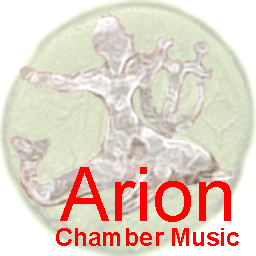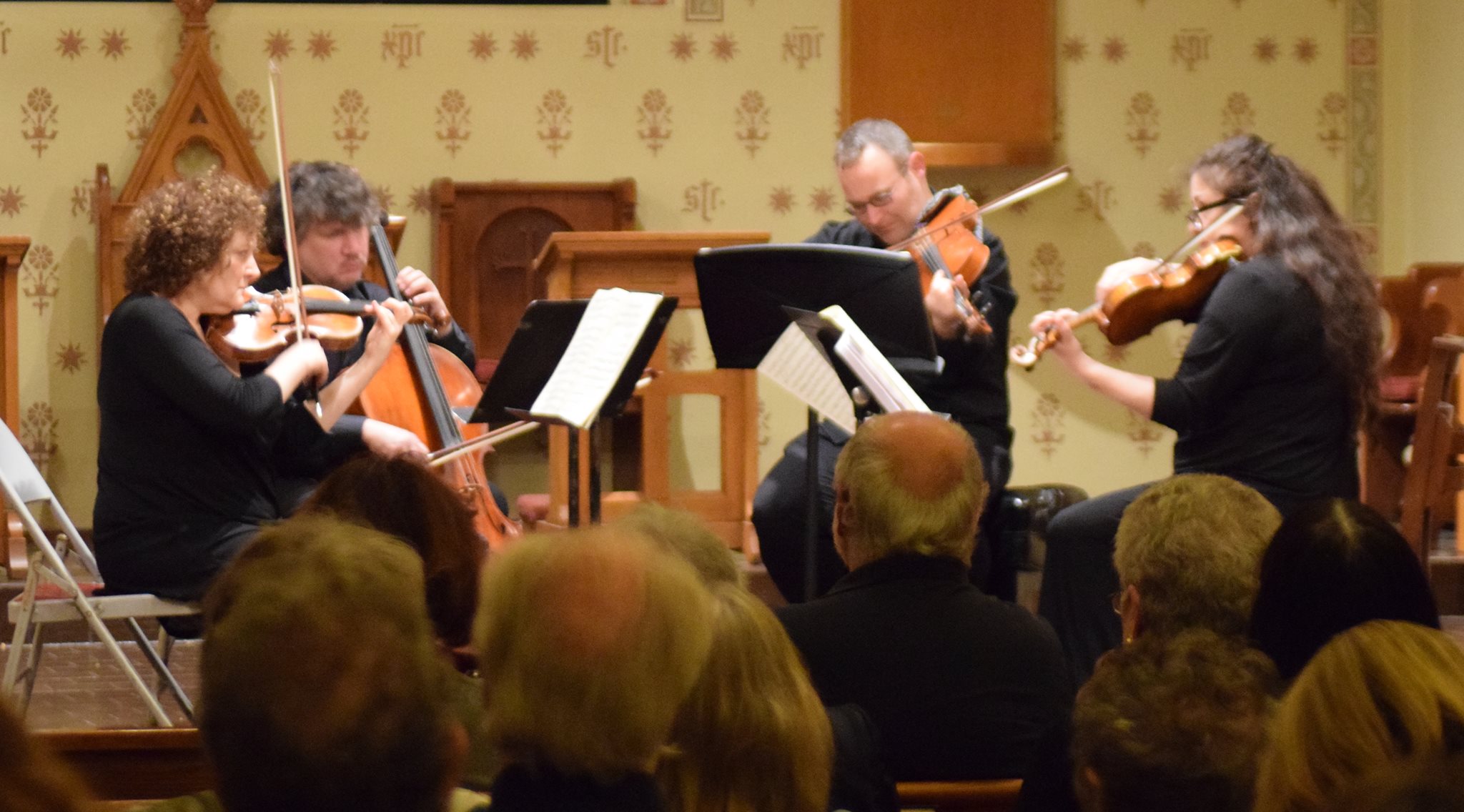Music for Strings Across Five Centuries
Christ and St. Stephen's Church, 120 West 69th Street, NYC
Arion Chamber Music opens its fourth season with its first string quartet concert. This production features a richly varied program of compositions for strings featuring the Dvořák “Terzetto” and Schubert’s “Quartettsatz” alongside works by Corelli, Mozart, and the innovative Russian-born composer Lev Zhurbin. Music Director Robert La Rue (cello) is joined by Lilit Gampel, Laura Goldberg (violins) and Mr. Zhurbin (viola).
Artists
- Laura Goldberg (violin) was a founding member of the Cassatt Quartet, and has been a prize winner in the Banff, Coleman, and Fischoff Competitions. Recipient of Yale University's Wardwell Fellowship, she is Director of Music at the Belvoir Terrace performing arts program in Lenox, Mass. and founder of ArtsAhimsa, an organization dedicated to promoting Peace and Nonviolence through the arts. She has served on the Pre-College faculty of the Juilliard School since 1985.
- Violinist Lilit Gampel enjoys a varied career as soloist, chamber musician, orchestral musician, and teacher. She has performed as guest soloist with the New York and Los Angeles Philharmonics, Boston Symphony, and the Concertgebouw, and has collaborated with the legendary Pierre Fournier, Kiril Kondrashin, and Zubin Mehta, among others. Her recitals have included appearances at the San Francisco Opera House and Chicago’s Symphony Hall. Gampel has also performed regularly as a member of the Mostly Mozart Festival, American Ballet Theatre, New York Chamber, and Gotham Chamber Opera orchestras. Gampel began studying violin at the age of six. Her mentors included Alice Schoenfeld and Ivan Galamian (Juilliard). Awards include first prize in the Coleman Chamber Music and Young Musicians' Foundation competitions, and the Jacob Javits Fellowship for graduate work in literature.
- Lev Zhurbin (viola), who composed one of the works on this program, was born in Russia and emigrated with his parents in 1990. As a composer he has received commissions from the City of London Sinfonia and the Louisville Orchestra, and has written works for Yo-Yo Ma's Silk Road Ensemble, Brooklyn Rider, and The Knights. With his ensemble, Ljova and the Kontraband, he has performed locally at Lincoln Center, the Brooklyn Academy of Music (as part of the Sundance Film Festival), and the Museum of Modern Art. He has taught at the Banff Center for the Arts in Canada and at the Princeton Atelier.
- Robert La Rue (cello) was First Prize Winner of the National Society of Arts and Letters Cello Competition, whose jury chairman was Mstislav Rostropovitch. Cellist of the Alcott Piano Trio and member of the cello trio, VC3, he also plays in the New York City Opera Orchestra. He is Music Director of Arion Chamber Music's concert series.
Notes on the Program
Arcangelo Corelli (1653-1713)
Sonate da chiesa a tre No. 2 and No. 8, Op. 3
Although there was never anything virtuosic in his style -- he was chiefly admired for the beauty of his sound and the unsentimental expressivity of his playing -- Arcangelo Corelli is widely regarded as history’s first ‘great’ violinist. From the time of his birth in 1653 (a little over a month after his father’s death) until his acceptance into the Accademia Harmonica of Bologna in 1670, virtually nothing can be substantiated with certainty about his life. It seems likely that he arrived in Bologna (an important musical center and hub of the relatively new art of violin playing) as early as 1666. From 1670 until 1675, when his name first appears in Rome in records of payment for musicians (as ‘Arcangelo bolognese’) there is another gap in the record. Early biographers filled this with extended European tours -- mostly notably a trip to Paris and an encounter with Lully -- for which no single scrap of historical evidence exists. By 1679 he had accepted a position as chamber musician in the household of Queen Christina of Sweden (who lived in Rome from the time of her abdication in 1655). His first published works, a set of twelve Sonate da chiesa [‘of the church’] a tre, Op. 1, are dedicated to her.
Corelli found his subsequent patrons mostly among princes of the Church in Rome -- most notably Cardinals Pamphili (the dedicatee of Corelli’s Op. 2) and Ottoboni, a nephew of Pope Alexander VIII. An exception was Francesco II d’Este, Duke of Modena, an enthusiastic amateur violinist and lavish musical patron. Corelli was resident in Modena for parts of 1689 and 1690, and dedicated his Opus 3 Sonate da chiesa (from which this evening’s selections are taken) to Francesco upon their publication in Rome.
It is believed that Corelli devoted considerable time and effort to polishing his compositions, preserving and publishing only those he regarded as particularly accomplished, so that they represent only a fraction of his total output as a composer. It is possibly partly for this reason that they gained instant and lasting popularity throughout Europe, most especially in Paris, the Netherlands, and London where Charles Burney wrote that “Corelli….reigned supreme in all concerts, and excited undiminished rapture [for] full half a century”.
W. A. Mozart (1756-1791)
String Quartet in C Major, K. 465 “Dissonance”
A year or so after settling permanently in Vienna, Mozart began work on a set of six string quartets which, at publication in 1785, he dedicated to Joseph Haydn, partly in homage to Haydn’s mastery of a form which he practically invented, but also as a tribute to a growing friendship between the two men (much less fraught than the later relationship between Haydn and Beethoven). “To my dear friend Haydn,” he wrote. “A father who had resolved to send his children out into the great world took it to be his duty to confide them to the protection and guidance of a very celebrated man, especially when the latter by good fortune was at the same time his best friend.” The last and in many ways the most distinguished of these six quartets is the C Major, K. 465.
The Adagio with which Mozart begins it, and which gives the piece its nickname (“Dissonance”) occupies a place in Western music similar to that of Wagner’s Prelude to Tristan und Isolde, with its famous ‘Tristan chord’. It anticipates by thirty years passages in the late Beethoven quartets that troubled listeners in a similar fashion. At the time of publication, several music dealers in Italy reportedly returned the scores to their publisher, believing they contained mistakes. Haydn expressed misgivings, but concluded “Well, if Mozart wrote it, he must have meant it.” Scholars and critics continued to be puzzled and disturbed by it for generations. The famous Belgian musicologist Fétis (who also blithely corrected what he believed to be ‘mistakes’ in Beethoven’s symphonies, which he edited) published a ‘corrected’ version of it.
The formal similarities between the Adagio-Allegro first movement of K. 465 and those of the Corelli sonatas on this evening’s program (Grave-Allegro and Largo-Allegro) will be apparent to listeners. It’s likely not coincidental that K. 465 dates from a period in Mozart’s life when he made his first serious studies of the music of Bach and Handel -- introduced to them by his patron, Baron van Swieten, who collected manuscripts by the Baroque masters. (Handel deliberately and self-consciously took Corelli as his model in the composition of his sonatas and concerti grossi; Bach more often followed Vivaldi’s example but he, too, wrote a number of sonatas in the form developed and perfected by Corelli.)
The dark uncertainties of the opening are banished by the sunny C major of the Allegro, and indeed by most of the remainder of the quartet, which follows a standard scheme of Andante second movement, Minuetto/Trio third movement, and sonata Allegro last movement. Mozart seems to devote a good deal of his attention to conventionalizing aspects of the dissonance and chromaticism that were so startling at the outset: in key structural moments (notably, the beginning of the development and coda sections of the first movement and the development of the last movement), more playfully in the Minuet and Trio and perhaps most subtly of all in the second theme of the Andante.
Antonin Dvořák (1841-1904)
Terzetto for Two Violins and Viola, Op. 74
By the end of 1886, Dvořák was enjoying considerable international success as a composer. He had just followed up his first ‘hit’, the Slavonic Dances of 1878, with an equally popular second set, and returned from only the most recent of his several concert tours of Great Britain, where he had conducted the premiere of his oratorio, St. Ludmila. His wide popularity was not reflected in the state of his finances (his publishers made far more money from the Slavonic Dances than he ever did), as exemplified by the fact that he was still living in his mother-in-law’s home, where a young chemistry student and amateur violinist, Josef Kruis, was also boarding. The two became friends and Dvořák resolved to write a piece that they could play together with Kruis’s violin teacher. In the space of a week (January 7th-14th, 1887), Dvořák produced the Terzetto. It proved to be too difficult for Kruis to manage; the immediate result of this was that Dvořák wrote another, simpler set of pieces, called Miniatures. (He obliged his publisher by turning them into a more saleable version for violin and piano.) The Terzetto was published in its original form, and had its premiere with the violist Karel Ondříček and two more advanced amateur violinists -- the doctor, Jan Buchal and Jaroslav Šťastný, a lawyer -- in late March, 1887.
The work is cast in four movements. An initial, ternary-form Introduzione in C Major is linked to the following Larghetto in the surprising but ultimately third-related key of E major. It is also in ternary form, with an agitato middle section. The third is a typical Scherzo/Trio with contrasting minor/major keys. The last is a set of ten short variations in which each begins in C minor and ends in C major, with tempo changes that build gradually to the molto allegro of the conclusion.
Franz Schubert (1797-1828)
“Quartettsatz” in C minor, D. 703
The first movement of a string quartet that Schubert abandoned in late 1820, the “Quartettsatz in C moll” (not to be confused with a much earlier work of the same title) is commonly regarded as one of the first -- if not the first -- of his mature works. ("The Wanderer Fantasy" dates from the same time.) Various historians have set forth theories about why he stopped work on the piece, including that he felt unable, at the time, to follow up the first movement with ideas of similar expressive depth and strength. (It is known that, in the aftermath of the Schubertiad of 1820, he felt a renewed ambition to compose large scale works of lasting value.) Also notable is the fact that, inspired by productions of two of his early operas in 1820, his interest in writing works for the stage was growing; he may simply have turned his attention in this direction.
The “Quartettsatz” did not receive its first performance until 1867 (March 1st, in Vienna), nearly half a century after it was written. The manuscript was acquired by Johannes Brahms and was edited by him for eventual publication in 1870. It was not immediately accepted as a work of importance. As late as 1905, one critic dismissed it airily as “fairly workman-like and effective, but….of little further consequence….only mentioned by way of completeness.” Over time, it has found its place in the repertoire alongside Schubert’s last quartets -- the Rosamunde, “Death and the Maiden”, and the ‘Great’ G Major -- some of the greatest achievements of his entire musical output.
Program Notes © Robert La Rue, 2018
|

